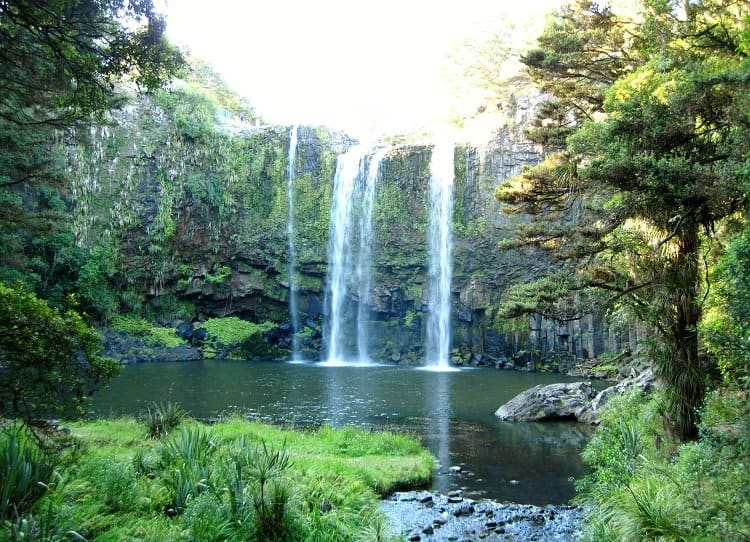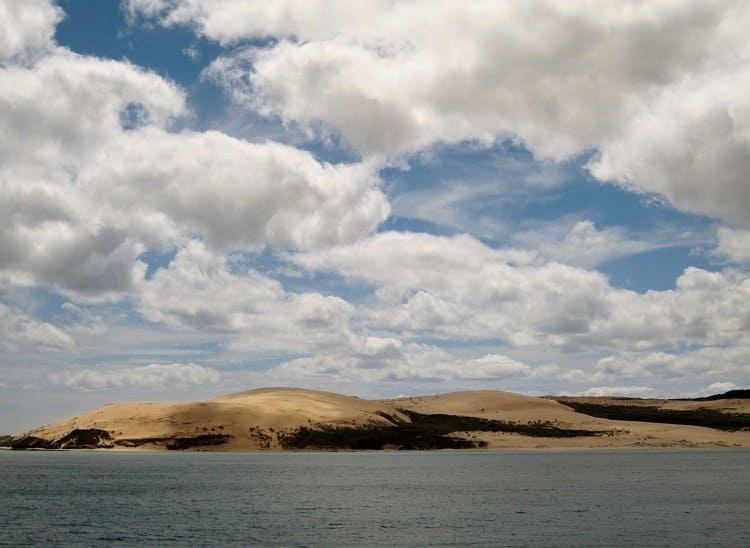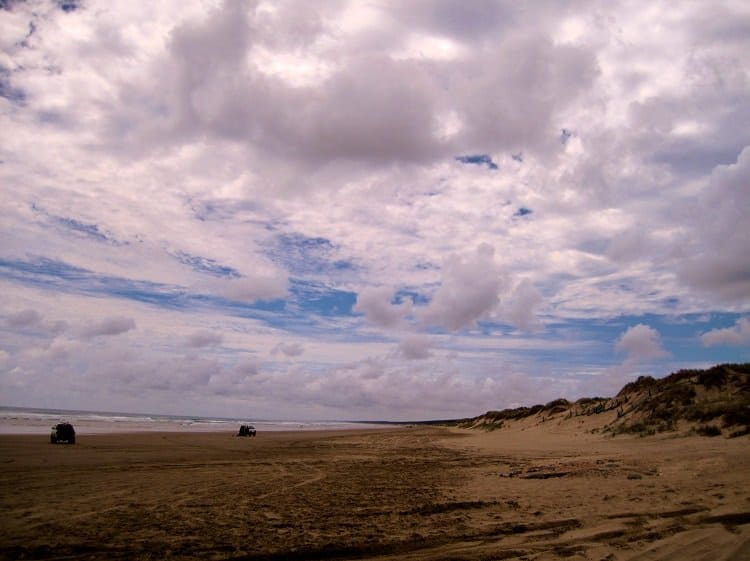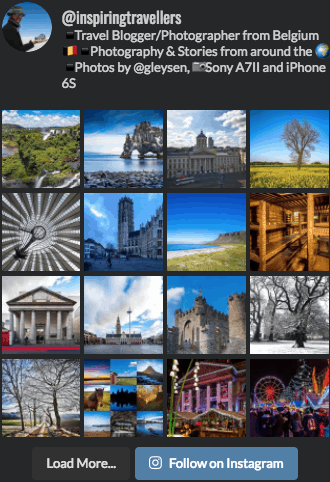It’s our third week in New Zealand and we’ve made our way up through the Northland region on the North Island. After several days in Auckland we were ready to experience some of ‘real’ New Zealand. I’m of the opinion that all parts of a country are the ‘real’ thing, but I can understand the importance of seeing the countryside and smaller towns and cities here. Northland is the subtropical region north of Auckland, filled with gorgeous stretches of coastline, harbours, sand dunes and forest. It is also rich in history, art galleries and opportunities for recreation.
I’m from the United States originally and I couldn’t help but notice its influence here in New Zealand, especially after coming from Australia. We witnessed children playing baseball and American regulation pool tables could be found in many bars. I don’t love chains, but I couldn’t help but smile at the sight of Wendy’s, Dunkin Donuts and Denny’s in Auckland. We took a wine tour and, for the first time in a long time, there were American tourists along with us; in fact, the tour seemed to cater to them. And the supermarkets sell beer and wine. Perhaps it’s the Polynesian influence (taking after Hawaii, perhaps) or the proximity to the US; either way, I’m recognising some of the familiar comforts of my country of birth.
But I digress…
Our journey began with a bus ride from Auckland to Whangarei, which promised a plethora of art galleries, cafes and natural attractions. We didn’t really plan this part of our trip very well in advance and just booked ten days in this town, planning to use it as a hub to explore other parts of Northland. It is summer here in New Zealand, which means it’s the high season and we’re in the middle of the school holiday period. Normally we don’t book in advance, but we did reserve most of our accommodation in New Zealand ahead of time for these reasons. I should also add that every single person we spoke to about New Zealand encouraged us to hire a car. We’re travelling for over two months and, quite frankly, didn’t want to deal with a car for all that time. Yes, you have freedom. Yes, New Zealand is known for hidden places that you must have a personal vehicle to access. Yes, we were open to hiring one when needed. But we’re public transport enthusiasts and (are still) determined to make our way through this country mostly via bus and train.
Well, we arrived in Whangarei and got off the bus to find a ghost town due to the observed public holidays. New Zealanders celebrate not only New Years Day as a public holiday, but also the day after. Because both New Years Day and Christmas this year fall on a Saturday, we’ve been treated to lots of fun public holiday surcharges and closures. That said, a surprising number of things have been open for business and without surcharge over the holiday period. Just not in Whangarei. We also weren’t happy with the accommodation we had booked. Some sly marketing tactics by the owners led us to believe that we were headed to a fun, laid-back backpackers, when in fact they are advertising a camping ground filled with families and screaming children two different ways. We actually discovered two separate brochures that were exactly alike except that one said “Holiday Park” and the other said “Backpackers.” And the double room we had booked was actually a tiny sauna far, far from the town centre. It certainly gets pretty hot and humid up here in Northland. So we shortened our time to only three days in Whangarei and made arrangements further north. After all, it would be silly to come to Northland and not spend most of our time in and around the Bay of Islands, which everyone raves about. On the day we were free from our biggest mistake yet, we picked up a rental car and headed west. After a brief stop in the logging town of Dargaville (reason to be revealed in time), we drove north along the Twin Coast Discovery Highway, stopping here and there to check out the coastline. Here powerful waves crash onto long stretches of empty, unspoilt sand (though these beaches are completely accessible). A bit further north we stopped in the Waipoua Forest to check out Tane Mahuta, also known as “Lord of the Forest.” At over 50 metres high, with a trunk girth of 13.77 metres, this giant Kauri is impressive. This forest houses the largest living Kauri trees in New Zealand. Kauri trees are some of the most ancient trees in the world, most of these felled in the 1800s.
Finally, we arrived in Hokianga and were greeted by giant golden sand dunes. The landscape quickly turned from green to gold, with a wide beautiful aqua harbour adding to the scenery. There isn’t much to do in Opononi, but after our last few days in Whangarei we wanted nothing more than to relax at our hotel and be in walking distance to a pub and restaurant. That said, it’s a nice spot; the town pub and restaurant are set right on the water with good food and a lively blend of locals and travellers passing through. If you’re going to bunk down anywhere in the west, here or neighbouring Omapere are the spots. These sister towns have a very Mediterranean flavour and nice lodgings are available. The next day we drove north. Sometimes when you go out exploring in the car you just don’t find very much of interest. This was the case for us on this trip. We took the car ferry across Hokianga Harbour (NZ$28 return) and drove further along the Twin Coast Discovery Highway. Our destination was the 90 Mile Beach on the northernmost peninsula. Ninety Mile Beach is actually only a 64 mile (103km) stretch of unspoilt sand from the town of Ahipara to Cape Reinga on the northernmost tip of the North Island of New Zealand. We stepped out onto the beach near Waipapakauri at a popular ramp where tour buses start their journeys up to the Cape. As we took pictures of the expanse of sand and sea a car came flying over a dune and did a burnout in the sand, scaring us half to death. Ninety Mile Beach is actually a designated road, with many cars rolling along the sand. We even saw a man in the passenger seat of his 4WD; his 10 year old son was the driver. Sensing danger, we cut our time here and headed back.
People looking for a place to pitch their tents, drive their boats, enjoy fishing or sand boarding amongst the dunes will be spoilt for choice in this part of Northland. Otherwise, we’re finding that there isn’t much of interest for the traveller. The upside is the slow pace of life and the very friendly people we encounter everywhere we go. It’s like stepping back in time several years for me, as I struggle to find internet access and encounter locals who ask what my iPad is. Petrol service stations are full service (for no extra charge) and the historical towns are left intact, old churches and farm houses dotting the landscape. Families find their spots along a favourite part of the coastline and camp together for their summer holidays. Coming from the big cities, the lifestyle here is noticeably different.
Check out our next post, which covers Northland’s most popular attraction: the Bay of Islands.






